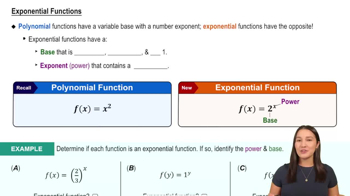Table of contents
- 0. Functions7h 52m
- Introduction to Functions16m
- Piecewise Functions10m
- Properties of Functions9m
- Common Functions1h 8m
- Transformations5m
- Combining Functions27m
- Exponent rules32m
- Exponential Functions28m
- Logarithmic Functions24m
- Properties of Logarithms34m
- Exponential & Logarithmic Equations35m
- Introduction to Trigonometric Functions38m
- Graphs of Trigonometric Functions44m
- Trigonometric Identities47m
- Inverse Trigonometric Functions48m
- 1. Limits and Continuity2h 2m
- 2. Intro to Derivatives1h 33m
- 3. Techniques of Differentiation3h 18m
- 4. Applications of Derivatives2h 38m
- 5. Graphical Applications of Derivatives6h 2m
- 6. Derivatives of Inverse, Exponential, & Logarithmic Functions2h 37m
- 7. Antiderivatives & Indefinite Integrals1h 26m
- 8. Definite Integrals4h 44m
- 9. Graphical Applications of Integrals2h 27m
- 10. Physics Applications of Integrals 2h 22m
4. Applications of Derivatives
Motion Analysis
Problem 3.7.101a
Textbook Question
{Use of Tech} A damped oscillator The displacement of a mass on a spring suspended from the ceiling is given by .
a. Graph the displacement function.
 Verified step by step guidance
Verified step by step guidance1
Identify the components of the displacement function: The function is y = 10e^{-t/2} * cos(πt/8). It consists of an exponential decay term 10e^{-t/2} and a cosine oscillation term cos(πt/8).
Understand the effect of each component: The exponential term 10e^{-t/2} represents damping, which means the amplitude of the oscillation decreases over time. The cosine term cos(πt/8) represents the oscillatory motion of the mass on the spring.
Determine the behavior of the function over time: As time t increases, the exponential term decreases, causing the overall amplitude of the oscillation to decrease. The cosine term will continue to oscillate between -1 and 1, but with a decreasing amplitude due to the damping effect.
Set up a graphing tool or software: Use a graphing calculator or software capable of plotting functions to visualize the displacement function. Input the function y = 10e^{-t/2} * cos(πt/8) into the tool.
Plot the function: Observe the graph to see how the displacement changes over time. Notice the oscillations with decreasing amplitude, which is characteristic of a damped oscillator. The graph should show a wave-like pattern that diminishes as time progresses.
 Verified video answer for a similar problem:
Verified video answer for a similar problem:This video solution was recommended by our tutors as helpful for the problem above
Video duration:
10mPlay a video:
Was this helpful?
Key Concepts
Here are the essential concepts you must grasp in order to answer the question correctly.
Damped Oscillator
A damped oscillator is a system in which the amplitude of oscillation decreases over time due to energy loss, often from friction or resistance. In the context of the given function, the term 'e^{-t/2}' represents the damping effect, indicating that the displacement will gradually diminish as time progresses.
Recommended video:

Cases Where Limits Do Not Exist
Exponential Function
An exponential function is a mathematical function of the form f(t) = a * e^{kt}, where 'e' is the base of natural logarithms, 'a' is a constant, and 'k' determines the rate of growth or decay. In the displacement function, the exponential term '10e^{-t/2}' signifies how the displacement decreases exponentially over time due to damping.
Recommended video:

Exponential Functions
Cosine Function
The cosine function is a periodic function that describes oscillatory motion, characterized by its amplitude, frequency, and phase shift. In the displacement equation, 'cos(πt/8)' indicates the oscillation of the mass, with a specific frequency that affects how quickly the mass moves back and forth, contributing to the overall behavior of the damped oscillator.
Recommended video:

Graph of Sine and Cosine Function

 6:29m
6:29mWatch next
Master Derivatives Applied To Velocity with a bite sized video explanation from Nick
Start learning




